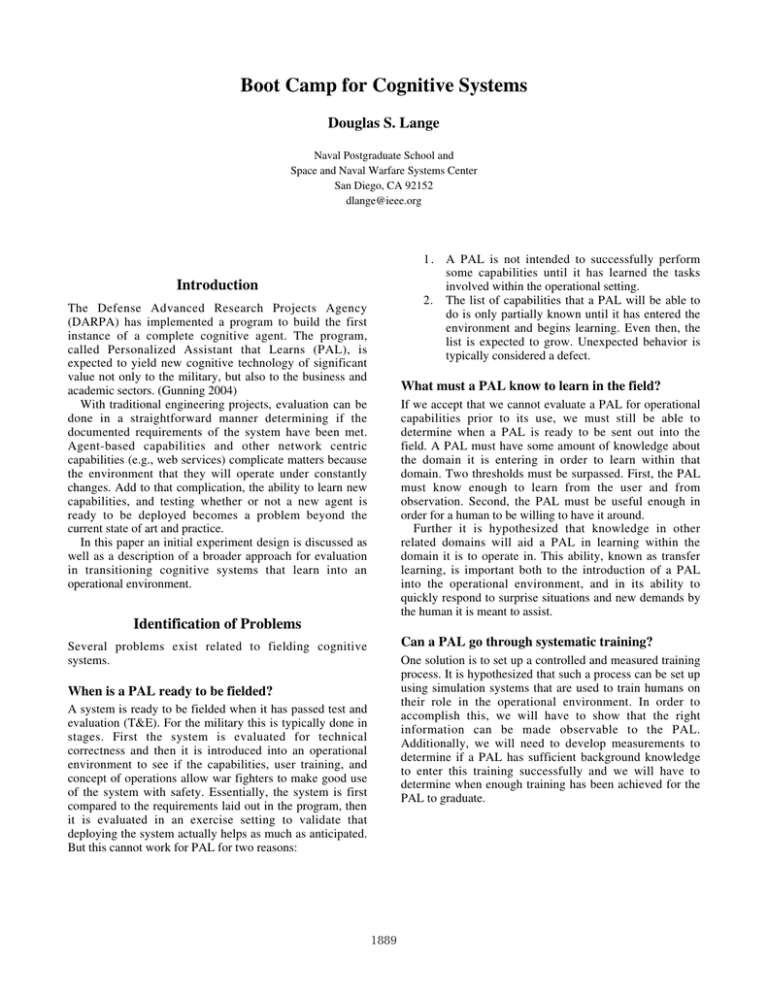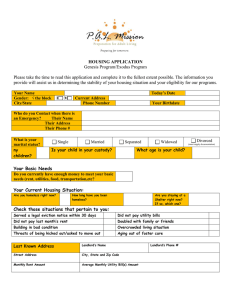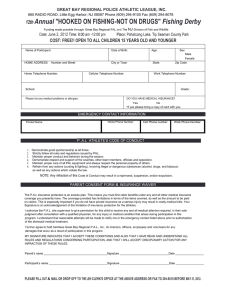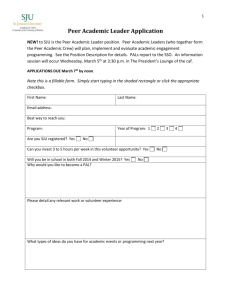Boot Camp for Cognitive Systems Douglas S. Lange
advertisement

Boot Camp for Cognitive Systems Douglas S. Lange Naval Postgraduate School and Space and Naval Warfare Systems Center San Diego, CA 92152 dlange@ieee.org 1 . A PAL is not intended to successfully perform some capabilities until it has learned the tasks involved within the operational setting. 2. The list of capabilities that a PAL will be able to do is only partially known until it has entered the environment and begins learning. Even then, the list is expected to grow. Unexpected behavior is typically considered a defect. Introduction The Defense Advanced Research Projects Agency (DARPA) has implemented a program to build the first instance of a complete cognitive agent. The program, called Personalized Assistant that Learns (PAL), is expected to yield new cognitive technology of significant value not only to the military, but also to the business and academic sectors. (Gunning 2004) With traditional engineering projects, evaluation can be done in a straightforward manner determining if the documented requirements of the system have been met. Agent-based capabilities and other network centric capabilities (e.g., web services) complicate matters because the environment that they will operate under constantly changes. Add to that complication, the ability to learn new capabilities, and testing whether or not a new agent is ready to be deployed becomes a problem beyond the current state of art and practice. In this paper an initial experiment design is discussed as well as a description of a broader approach for evaluation in transitioning cognitive systems that learn into an operational environment. What must a PAL know to learn in the field? If we accept that we cannot evaluate a PAL for operational capabilities prior to its use, we must still be able to determine when a PAL is ready to be sent out into the field. A PAL must have some amount of knowledge about the domain it is entering in order to learn within that domain. Two thresholds must be surpassed. First, the PAL must know enough to learn from the user and from observation. Second, the PAL must be useful enough in order for a human to be willing to have it around. Further it is hypothesized that knowledge in other related domains will aid a PAL in learning within the domain it is to operate in. This ability, known as transfer learning, is important both to the introduction of a PAL into the operational environment, and in its ability to quickly respond to surprise situations and new demands by the human it is meant to assist. Identification of Problems Can a PAL go through systematic training? Several problems exist related to fielding cognitive systems. One solution is to set up a controlled and measured training process. It is hypothesized that such a process can be set up using simulation systems that are used to train humans on their role in the operational environment. In order to accomplish this, we will have to show that the right information can be made observable to the PAL. Additionally, we will need to develop measurements to determine if a PAL has sufficient background knowledge to enter this training successfully and we will have to determine when enough training has been achieved for the PAL to graduate. When is a PAL ready to be fielded? A system is ready to be fielded when it has passed test and evaluation (T&E). For the military this is typically done in stages. First the system is evaluated for technical correctness and then it is introduced into an operational environment to see if the capabilities, user training, and concept of operations allow war fighters to make good use of the system with safety. Essentially, the system is first compared to the requirements laid out in the program, then it is evaluated in an exercise setting to validate that deploying the system actually helps as much as anticipated. But this cannot work for PAL for two reasons: 1889 While the game is being played, PAL should be learning. Following this learning phase an exam will be administered much like is done currently to monitor the progress of the learning capability being developed by PAL. After the simulation and the exam are completed, PAL will enter normal operations. In our experiments, this will be a different simulation with different human actors and with game aspects that were completely untouched in the first round. Boot Camp People are trained before entering new environments in the military. The basics are taught at a boot camp. Similarly, staff officers are trained in processes such as Crisis Action Planning before they join a unified command. Since crises almost by definition are not very predictable, most of what officers learn is on-the-job training, but still it is found useful to train, and test the knowledge of individuals before they go into such environments. This ensures that the background knowledge needed is in place to allow a person to learn quickly in their new job. A PAL faces the same challenge with the added complication, that if it is not found useful in the field, it will not be used and therefore, will certainly not learn. A solution is to immerse a PAL into a similar training environment, or perhaps the same training environment as human’s are trained in. The key is measuring when a PAL has learned a sufficient amount. If we can measure PAL performance in operational use and relate that back to the training, we can determine if there is a benefit to running further training sessions. Measurements The primary measurements must demonstrate whether or not PAL is able to learn at a sufficient rate to become useful. It is expected that when first fielded, the user’s effectiveness will not improve for some period of time, and efficiency will actually drop. After an initial use period, efficiency and effectiveness should improve beyond what the user is able to do alone. Specification of a system will then be based on acceptable variation in initial performance and required improvements over time. These are expressed in statistical terms. Regression analysis (Cohen 1995) of performance compared to results from the exams will hopefully yield correlation between training results and operational results. We will also be using state-trace analysis (Bamber 1979) to determine if we can show that the boot camp accelerated the ability to learn in the operational environment despite differences in domains. This is an instance of transfer learning discussed in (Marx et. al. 2005) and we will also be using their methods of measurement. Their methods will be used to evaluate improvements in performance based on the transfer learning, while Bamber’s will separate out improvements in learning capability due to transfer. The Boot Camp Experiment In 2004-5, the Space and Naval Warfare Systems Center San Diego (SSC SD), in conjunction with the Naval Postgraduate School (NPS) and SRI, conducted a series of experiments called Command World (Wong et. al. 2006). Command World was a simulation of a Crisis Action Planning (CAP) process executed by military officers playing staff officer roles. Among the results from Command World, was the knowledge that we could use such an environment to stimulate a PAL, making information observable through instrumentation. Modeling of the learning by a PAL is being performed. Through simulation, we hope to show the conditions needed for successful training of the assistant. These will then be compared to the next experiments to verify behaviors found in the model. The next series of Command World experiments will tie PAL to the Joint Semi- Automated Forces (JSAF) simulation environment. In a pre-simulation phase, a task analysis will be done and the minimum necessary ontology will be provided to PAL in order to bootstrap learning. Problems will be posed through the JSAF environment. Tactical information is passed to the Composeable FORCEnet (CFn) command and control capability, with communications instrumented so that PAL can read message traffic. Players will collaborate using a combination of CFn and IRIS (a user interface to PAL that includes capabilities such as email and chat). All collaboration tools and user access to information are instrumented. Players must compose a force to address the tactical situation in the game through JSAF. The game then continues with the outcomes reported through the tactical communications and new problems presented. References Bamber, D., “State-trace analysis: A method of testing simple theories of causation”, Journal of Mathematical Psychology, 19:137-181. Cohen, P., 1995, Empirical Methods for Artificial Intelligence, Cambridge, MA: The MIT Press. Gunning, D., 2004, “Beyond Science Fiction: Building a Real Cognitive Assistant”, DARPATech 2004, Anaheim, CA. Marx, Z., Rosenstein, M., Kaelbling, L., and Dietterich, T, 2005, “Transfer learning with an ensemble of background tasks “,NIPS 2005 Workshop on Inductive Transfer: 10 Years Later. Whistler, British Columbia. Wong, L., Lange, D., Sebastyn, J., and Roof, W., 2006, “Command World”, Proceedings of Command and Control Research and Technology Symposium, San Diego, CA. Forthcoming. 1890




